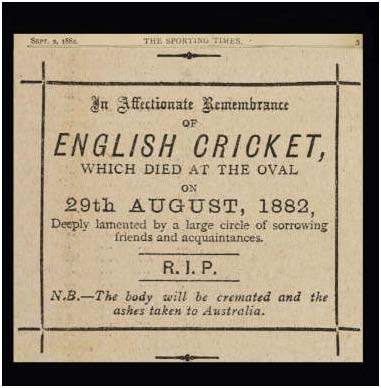If you are English or Australian and love cricket then there is no more important sporting event than the biennial Ashes series. The genesis of these great contests date back to 1882 when Australia beat England for the first time in England at the Oval in London. The next day a satirical obituary was published in The Sporting Times which stated that English cricket had died, and the body will be cremated and the ashes taken to Australia.

The next tour in 1882-83 was dubbed as the quest to regain the Ashes. During that tour a group of Melbournian women presented the England captain with a small terracotta urn. Much to the grumpiness of Australia, the Urn stays at Lords even if Australia wins and a replica urn is presented to the winning teams.
Great Ashes contests
The romance of this cricket series is built on amazing ashes performances. In my lifetime two stand out. In 1981 I was 12 years old. My hero was Ian Botham – our swashbuckling all-rounder and captain of England. The first two games of that series were a disappointment. England were beaten in the first and drew the second test with Botham being dismissed for a pair at Lords. This prompted Botham to resign as captain.
At Headingly (known for having snakes in the pitch) Australia won the toss and declared at tea on day two at 401 for 9. Botham took 6 wickets in that innings. When England batted only Botham made runs (a 50) and England were bowled out for 174. Naturally, Australia enforced the follow-on. England slumped to 41-4 and 105-5 as Botham came out to bat. With batsmen falling around him England looked certain to be beaten by an innings at 137 for 7. But that is not how Botham played; batting with the tail he scored 145 not out and helped England take a slender lead of 145. Botham then took the first wicket before (grumbling) Bob Willis ran through the Aussies bowling them out for 111. It was only the second time in test history that a team following-on had won a test match.
In the next match at Edgbaston, England did little better. Australia needed 151 to win in the final innings and at 105-5 looked well set to take the series victory. Botham then took 5 wickets for 1 run in 28 balls to give England the win by 29 runs. I remember shouting with excitement at our black and white television. The next test was more of a team effort but Botham scored 118 runs when England again looked scratchy (with several sixes off the menacing Lillie). The Oval Test was a draw and England won the series 3-1. Botham scored 399 runs and took 34 wickets in the series – what a performance!
More to come next week in Part 2.
Paul Noon
Deputy Consul-General & Director of Trade and Investment, Australia

1 comment
Comment by Bob O'Meara posted on
Brilliant, blog of the year, Part 2 better be good, you've set the bar very high though.